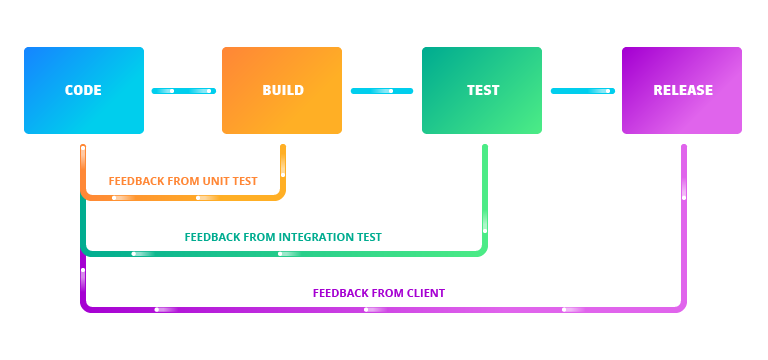The fast-paced growth of technology requires continuous or faster deployment. Continuous Integration structure (Figure 1) is a strategy of integrating changes in a developer’s code into the source branch as quickly as possible. Tests are automated against the standard code base to validate that the new code does not have errors.
This helps streamline the development task. Continuous integration tools provide a platform for developers to get immediate reports in case of vulnerabilities or flaws with a code. This report enables the developers to take corrective action on time. Here, the testing process is automated. Test results are instantly reported to the user.
A crucial procedure in contemporary software development, continuous integration/continuous delivery and deployment (CI/CD) seeks to accelerate the integration and delivery of code updates. CICD tools assist development teams in ensuring the stability and quality of their codebase by automating the process of developing, testing, and releasing software. Several CI technologies have become market leaders in 2024, offering developers strong features and increased productivity. We will examine the best six continuous integration tools in this review post, which you just cannot afford to miss this year.
Check out our free courses to get an edge over the competition
Figure 1: Continuous Integration Structure

Automating Website Deployments Through Buddy — Smashing Magazine
9 Best Continuous Integration Tools
Choosing the right continuous integration tools is essential. The right tool needs to ease the process of the development cycle. Here pricing, ease of integration, updates, and features, including security, need to be considered while making the best choice. Here are the best CI tools available in the market:
”
upGrad’s Exclusive Software Development Webinar for you –
SAAS Business – What is So Different?
”
Jenkins
(Latest release – Jenkins 2.256 LTS (2020-09-08))
In 2024, Jenkins, the most well-liked CI tool, will still rule the market. Developers can personalise their CI workflows thanks to the variety of plugins and connections it offers. Jenkins provides powerful features for creating, testing, and deploying applications while supporting several programming languages. Its sizable community guarantees continuous upgrades and broad support.
Jenkins is the most popular and widely used open-source continuous integration tool. Jenkins is a server-based tool that allows developers to build, test, and deploy their software fast reliably. It is built with Java and provides close to 1700 plugins to automate development processes.
Jenkins provides WAR files, native packages, Docker images, and installers for Windows and Linux distribution platforms.
Features of Jenkins
- Easy installation, configuration, self-contained, platform-agnostic Java-based program easily available for Mac OS, Linux, and Windows platform.
- Available plugins, large numbers of plugins available in the update center, integrating every tool of CI plugin.
- Easy Distribution can easily be disrupted across the workstations.
- Bigger community support for this open-source tool.
- The easy package is available to be deployed on the public cloud.
Check out upGrad’s Java Bootcamp
TeamCity
Latest release (TeamCity 2020.1 (2020-05-09)
TeamCity is a continuous integration and management server built by JetBrains. It supports .Net, Java, and Ruby platforms. Key integration allows with Docker, Jira, Maven, Visual Studio team services, NuGet, and VCS Hosting services. Microsoft Azure and Google Cloud integration plugins are also available.
Features of TeamCity
- Remote Run and Pre-Tested Commit: These features are provided via IDE plugins for IntelliJ IDEA-based products, Microsoft Visual Studio, and Eclipse.
- Problem and Test Management: Several persons can be assigned for investigation of issues in one build.
- Automatic Investigation Assignment: automatically assign investigations to team members based on several heuristics
- Notifications: Notification via email, instant messenger, and Slack platforms.
Check out upGrad’s Full Stack Development Bootcamp (JS/MERN)
Explore Our Software Development Free Courses
Buddy
Latest release (Buddy v2.3.57 (2020-08-09))
Buddy is a Continuous integration and continuous delivery tool specially developed for web developers as it is web-based. This tool is well known for its user-friendly interface. It well matches Git developers’ interest, and they can use this tool to build, test, and deploy web-based applications as well as websites with the use of Bitbucket, GitHub, and GitLab codes.
Features of Buddy
- Docker-based builds and tests
- 10-minute setup of the complete environment
- Automatic deployments on a push to a branch
- Buddy-on-premises: on-premises features version, which only requires a server with docker installed.
Bamboo CI
Latest release (Bamboo 7.1 (2020-07-24))
Atlassian developed Continuous bamboo Integration in the year 2006. The bamboo server is an automation server used for continuous integration. Bamboo CI is well known for its good User Interface and automated merging.
Atlassian’s Bamboo offers development teams an all-inclusive CI/CD solution. It provides capabilities that are simple to use and straightforward for creating, testing, and releasing applications. The seamless integration of Bamboo with JIRA, Bitbucket, and other Atlassian technologies allows for effective teamwork throughout the whole development process. It may be customised to meet the needs of various projects thanks to its extensibility through plugins.
Features of Bamboo CI
- Built-in Git branching workflows
- Test Automation
- Easy Enterprise-grade permission management
- Built-in deployment support
- Eases test automation
GitLab CI/CD
Latest release (GitLab 13.4 (2020))
It helps to manage the complete software development cycle; it also consists of mini tools performing different sets of roles. This is an open-source tool owned by GitLab Inc. This tool allows applying all the continuous methods, continuous integration, delivery, and deployment without the use of any third-party applications or integration. To use the GitLab CI/CD, all you require is a codebase hosted in a Git repository.
GitLab provides an all-encompassing DevOps platform with CI/CD capabilities. Developers can control every stage of the software development lifecycle with GitLab CI/CD from a single interface. It offers strong features including container registry, bug tracking, and code review. GitLab CI/CD is perfect for large-scale projects because it allows auto-scaling and parallel execution.
Explore our Popular Software Engineering Courses
Features of GitLab CI
- Schedule pipelines.
- Deploy your app to different environments.
- Check for app vulnerabilities with Security Test reports.
- Easily set up your app’s entire lifecycle with Auto DevOps.
Read: GitHub vs GitLab: Difference Between GitHub and GitLab
Buildbot
Latest release: Buildbot 2.4.1 (2019- 09 – 11)
Build bot is an automation tool, and its configuration files are based on python scripting, which automates the compile or test. At the core of Buildbot, it is a job scheduling system. The jobs are queried and executed when the resource is available later, the results are shown instantly. The Buildbot is written in python on top of twisted libraries. Buildbot is widely used in web browser development and is used in Mozilla, Webkit, Chromium.
In-Demand Software Development Skills
Features of Buildbot
- Flexible configuration by subclassing generic build process classes.
- Notification functions supported: Gerrit Status Push, Email Notification, Stash Status Push, PBListener, etc.
- Status delivery through a web page, email, IRC, other protocols.
- Version control systems supported: Gerrit, Monotone, Subversion, Darcs, etc.
Also Read: Continuous Delivery vs. Continuous Deployment: Difference Between
Get Software Engineering degrees from the World’s top Universities. Earn Executive PG Programs, Advanced Certificate Programs, or Masters Programs to fast-track your career.
Read our Popular Articles related to Software Development
| Why Learn to Code? How Learn to Code? | How to Install Specific Version of NPM Package? | Types of Inheritance in C++ What Should You Know? |
CircleCI
CircleCI is a cloud-based continuous integration platform that makes the process easier. It offers quick and effective builds, executing tests concurrently to shorten execution time. Numerous programming languages are supported by CircleCI, which also smoothly interfaces with well-known platforms and tools for development. It is a fantastic option for teams of all sizes due to its user-friendly interface and thorough documentation.
Travis CI
Travis CI is a popular CI tool that is renowned for its simplicity and use. Since it seamlessly integrates with GitHub, it is well-liked by open-source projects. Multiple programming languages are supported by Travis CI, which also offers flexible build setups. Its widespread use is aided by its thorough documentation and helpful community.
Azure Pipelines
Azure Pipelines is a cloud-based CI/CD tool that is a component of Microsoft’s Azure DevOps portfolio. It provides an infrastructure that is incredibly versatile and scalable for creating, testing, and deploying applications. Azure Pipelines is compatible with multiple development stacks because it supports multi-platform and multi-language environments. For organisations with existing Microsoft ecosystem investments, its interoperability with other Azure services makes it a desirable option.
In 2024, there will be a wealth of potent CICD tools available for continuous integration that will meet the various demands of software development teams. The top CI tools that every developer should be aware of include Jenkins, CircleCI, GitLab CI/CD, Travis CI, Azure Pipelines, and Bamboo. Teams may automate their build and deployment procedures with these technologies, leading to quicker and more reliable software delivery. These technologies offer the functionality you need to simplify your CI workflows, whether you want an open-source option like Jenkins or a cloud-based service like CircleCI. Maintain a current understanding of continuous integration’s most recent developments to boost team efficiency and produce high-calibre software.
Conclusion
The best available Continuous Integration tools are listed above. This information is insightful for developers who plan to get a career in IT automation and manage automation tools to build and deploy various aspects of Software development projects. Continuous Integration, Continuous Delivery, and Continuous Deployment are very critical and complex servers.
Choosing the right CI tool helps your project progress well. Features provided in the tool and project functionalities need to match. It’s not about choosing the best tool but multiple tools. As the career in automation grows, skilled professionals in handling continuous integration tools are increasing.
Learning new skills might be difficult and confusing to start. upGrad eases this with their postgraduate e-learning courses. Courses are tailored to students of all levels of expertise. Courses provide you with hands-on experience with tools, which is essential for securing a high paying job.
If you’re interested to learn more about full-stack development, check out upGrad & IIIT-B’s Executive PG Program in Full-stack Software Development which is designed for working professionals and offers 500+ hours of rigorous training, 9+ projects, and assignments, IIIT-B Alumni status, practical hands-on capstone projects & job assistance with top firms.
































![Full Stack Developer Salary in India in 2024 [For Freshers & Experienced]](/__khugblog-next/image/?url=https%3A%2F%2Fd14b9ctw0m6fid.cloudfront.net%2Fugblog%2Fwp-content%2Fuploads%2F2019%2F10%2FBlog_FI_Nov_Full-Stack-Developer-Salary.png&w=3840&q=75)
![SQL Developer Salary in India 2024 [For Freshers & Experienced]](/__khugblog-next/image/?url=https%3A%2F%2Fd14b9ctw0m6fid.cloudfront.net%2Fugblog%2Fwp-content%2Fuploads%2F2020%2F05%2F477.png&w=3840&q=75)
![Library Management System Project in Java [Comprehensive Guide]](/__khugblog-next/image/?url=https%3A%2F%2Fd14b9ctw0m6fid.cloudfront.net%2Fugblog%2Fwp-content%2Fuploads%2F2020%2F08%2F769.png&w=3840&q=75)
![Bitwise Operators in C [With Coding Examples]](/__khugblog-next/image/?url=https%3A%2F%2Fd14b9ctw0m6fid.cloudfront.net%2Fugblog%2Fwp-content%2Fuploads%2F2020%2F10%2F1252.png&w=3840&q=75)
![ReactJS Developer Salary in India in 2024 [For Freshers & Experienced]](/__khugblog-next/image/?url=https%3A%2F%2Fd14b9ctw0m6fid.cloudfront.net%2Fugblog%2Fwp-content%2Fuploads%2F2020%2F05%2F478.png&w=3840&q=75)
![Password Validation in JavaScript [Step by Step Setup Explained]](/__khugblog-next/image/?url=https%3A%2F%2Fd14b9ctw0m6fid.cloudfront.net%2Fugblog%2Fwp-content%2Fuploads%2F2019%2F07%2FBlog_FI_July_upGrads-Knowledge-base.png&w=3840&q=75)


